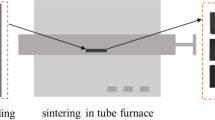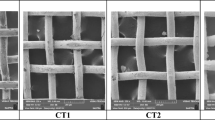Abstract
The condensed working fluid inside a heat pipe is pumped from the condenser to the evaporator section to complete the operating cycle by using the capillary force generated inside the wick structure. Since the miniature heat pipes have smaller vapor cross-sectional area, the fiber wick structure is suitable for this application. The fiber wick structure can be designed to provide an excellent flow path for the working fluid with an optimum configuration based on a hexagonal fiber arrangement. By a microscopic investigation of the wick structure, the porosity can be related with the physical properties, effective pore radius and the capillary pressure. The effective pore radius and the capillary pressure are important parameters to characterize the permeability because it enables one to predict the flow rate obtainable under a given pressure drop necessary to achieve a specific circulation condition, which affects the heat transfer for the heat pipes. In this study, the effect of the porosity on the effective pore radius and the capillary pressure are discussed. The rate of the test liquid rise has been used to estimate the permeability on several fiber wick samples where the porosity varies. The optimum porosity of the fiber wick structure in miniature heat pipes is found at 0.45 while the permeability approaches the maximum value of 1.26 × 10−12 m2 which results in an excellent circulation of the working fluid from the condenser to the evaporator section. Moreover, the capillary performance (K/reff) of the fiber wick is further investigated for the thermal evaluation of heat pipes. The values of the maximum heat transfer rate due to capillary limit from our prediction reach to 1.81 and 2.68 W for heat pipe diameters of 2 and 3 mm, which contain sintered fiber wick structures under optimum design conditions.












Similar content being viewed by others
Abbreviations
- a :
-
radius of the particle, m
- A :
-
cross –sectional area of the porous medium, m2
- b :
-
Kozeny-Carman constant
- d :
-
wire or powder diameter, m
- D :
-
fiber diameter, m
- D h :
-
effective hydraulic diameter, m
- g :
-
gravitational acceleration, m/s2
- h f :
-
major loss due to friction, m
- h fg :
-
latent heat, J/kg
- l eff :
-
effective length of the heat pipe, m
- L :
-
length of the porous medium, m
- m f :
-
fiber mass, kg
- m w :
-
water mass, kg
- N :
-
number of fibers
- ΔP c :
-
capillary pressure difference, Pa
- ΔP hs :
-
hydrostatic pressure difference, Pa
- ΔP f :
-
pressure loss, Pa
- q :
-
volume flow rate per unit area, m/s
- Q :
-
heat transfer rate, W
- r eff :
-
effective pore radius, m
- r σ :
-
capillary radius, m
- s :
-
surface area of the capillary channel, m2
- S :
-
distance between fiber, m
- t :
-
time, s
- v :
-
fluid velocity, m/s
- f:
-
fiber
- w:
-
water
- min:
-
minimum value
- max:
-
maximum value
- μ :
-
fluid viscosity, Pa. s
- ε :
-
porosity
- ρ :
-
fluid density, kg/m3
- σ :
-
surface tension, N/m
References
Mochizuki M, Saito Y, Nguyen T, Mashiko K, Kumthonkittkun V, Kuriyama H Ektummakii P (2004) The development of composite wick heat pipe, Proc. of the 1st International Seminar on Heat Pipe and Heat Recovery System, Malaysia
Ru J, Kong B, Zhu H, Shi Z, Zhang D, Fan T (2014) Microstructure, capillary performance and gas permeability of Biporous copper fabricated by tape casting. Powder Technol 256:182–187
Tamayol A, Bahrami M (2010) Parallel through ordered fibers: an analytical approach. J Fluids Engineering 132:1–7
Li J, Zou Y, Cheng L (2010) Experimental study on capillary pumping performance of porous wicks for loop heat pipe. Exp Thermal Fluid Sci 34(8):1403–1408
Holley B, Faghri A (2006) Permeability and effective pore radius measurements for heat pipe and fuel cell applications. Appl Therm Eng 26(4):448–462
Zhu N, Vafai K (1996) Optimization of asymmetrical disk-shaped heat pipes, AIAA. J Thermophys Heat Transfer 10:179–182
Zhu N, Vafai K (1996) The effects of liquid-vapor coupling and non-Darcian transport on asymmetrical disk-shaped heat pipes. Int J Heat Mass Transf 39:2095–2113
Zhu N, Vafai K (1997) Numerical and analytical investigation of vapor flow in a disk-shaped heat pipe incorporating secondary flow. Int J Heat Mass Transf 40:2887–2900
Zhu N, Vafai K (1998) Vapor and liquid flow in an asymmetrical flat plate heat pipe-a three dimensional analytical and numerical investigation. Int J Heat Mass Transf 41:159–174
Zhu N, Vafai K (1998) Analytical modeling of the startup characteristics of asymmetrical flat-plate and disk-shaped heat pipes. Int J Heat Mass Transf 41:2619–2637
Zhu N, Vafai K (1999) Analysis of cylindrical heat pipes incorporating the effects of liquid-vapor coupling and non-Darcian transport-a closed form solution. Int J Heat Mass Transf 42:3405–3418
Shafahi M, Bianco V, Vafai K, Manca O (2010) An investigation of the thermal performance of cylindrical heat pipes using Nanofluids. Int J Heat Mass Transf 53:376–383
Shafahi M, Bianco V, Vafai K, Manca O (2010) An investigation of the thermal performance of flat-shaped heat pipes using Nanofluids. Int J Heat Mass Transf 53:1438–1445
Alizad K, Vafai K, Shafahi M (2012) Thermal performance and operational attributes of the startup characteristics of flat-shaped heat pipes using Nanofluids. Int J Heat Mass Transf 55:140–155
Ghanbarpour M, Khodabandeh R, Vafai K (2016) An investigation of thermal performance improvement of a cylindrical heat pipe using nanofluid. Heat Mass Transf J 53(3):973–983. https://doi.org/10.1007/s00231-016-1871-9
Vafai K, Wang W (1992) Analysis of flow and heat transfer characteristics of an asymmetrical flat plate heat pipe. Int J Heat Mass Transf 35:2087–2099
Vafai K, Zhu N, Wang W (1995) Analysis of asymmetric disk-shaped and flat plate heat pipes. ASME J Heat Transfer 117:209–218
Shirazy MRS, Frechette LG (2013) Capillary and wetting properties of copper metal foams in the presence of evaporation and sintered walls. Int J Heat Mass Transf 58(1–2):282–291
Peterson GP (1998) An introduction to heat pipes: modeling, testing, and applications. John Wiley & Sons Inc., New York
Byon C, Kim SJ (2012) Capillary performance of bi-porous sintered metal wicks. Int J Heat Mass Transf 55:4096–4103
Weibel JA, Garimella SV, North MT (2010) Characterization of evaporation and boiling from sintered powder wicks fed by capillary action. Int J Heat Mass Transf 53:4204–4215
Bayramli E, Powell RL (1991) Experimental investigation of the axial impregnation of oriented Fiber bundles by capillary forces. Colloids Surf 56:83–100
Dunn PD, Reay DA (1978) Heat pipes. Pergamon Press, New York
Adkins DR, Dykhuizen RC (1993) Procedures for measuring the properties of heat-pipe wick materials, American Chemical Society. Proc. of 28th Intersociety Energy Conversion Engineering Conf., Washington, D.C. 2:911–917
Faghri A (1995) Heat pipe science and technology. Taylor and Francis, Washington, D.C.
Kozeny J (1927) Ueber Kapillare Leitung des Wassers im Boden. Stizungsber Akad Wiss Wien 136
Carman PC (1937) Fluid flow through granular beds. Trans Inst Chem Eng 15:150
Carman PC (1939) Permeability of saturated sands, soils and clays. J Agric Sci 29:263–273
ESDU (1979) Heat pipes – properties of common small-pore wicks, data item no. 79013. ESDU International plc, London
Dong M, Dullien FAL (1997) A new model for immiscible displacement in porous media. Transp Porous Media 27(2):185–204
Vafai K (2009) Handbook of porous media. Marcel Dekker, Inc, New York
Espinosa FAD, Peters TB, Brisson JG (2012) Effect of fabrication parameters on the thermophysical properties of sintered wicks for heat pipe application. Int J Heat Mass Transf 55:7471–7486
Nam Y, Sharratt S, Byon C, Kim SJ, Ju YS (2010) Fabrication and characterization of the capillary performance of superhydrophilic cu micropost arrays. J Microelectromech Syst 19(3):581–588
Acknowledgements
This research has been supported by the Thailand Research Fund (TRF), Thailand (Contract number PHD58I0061) and Fujikura Electronics (Thailand) Ltd. The authors would like to express their sincere appreciation for all of the support provided.
Author information
Authors and Affiliations
Corresponding author
Ethics declarations
Conflict of interest
There is no conflict of interest. This manuscript has not been submitted to anywhere else.
Additional information
Publisher’s note
Springer Nature remains neutral with regard to jurisdictional claims in published maps and institutional affiliations.
Highlights
In this work a thorough analysis of the effect of porosity on the effective pore radius and the capillary pressure were performed. In this study, each single wick fiber wick is packed in a hexagonal array creating a porosity variation from 0.19-0.91. Our results show that this alters the flow and heat transfer characteristics and the effects of various parameters is presented.
The following key conclusions can be drawn from this study.
(1) For 50-micron fibers packing, the critical pore radius for the packing is found to be 117 μm to maintain the pumping force by the capillary action.
(2) The capillary pressure becomes almost zero when the fiber packing is at the maximum effective pore radius which decreases the pumping force and subsequently the liquid mass hardly rises along the parallel capillary flow path.
(3) To evaluate the optimum configuration of the fiber wick structure in heat pipes with proper porosity and high capillary pressure, the permeability is determined in order to simultaneously analyze proper working fluid circulation from condenser to the evaporator section.
(4) The porosity of 0.45 is found to be optimum for fiber wick structure in miniature heat pipes for obtaining the best liquid flow performance with a permeability of 1.26×10−12 m2.
(5) The maximum capillary performance was found to be approximately at 0.12 and 0.10 μm for 0.825±0.02 and 1.481±0.05 mm2 of the fiber wick area.
(6) The values of the maximum capillary limit from our simulations were found to be 1.81 and 2.68 W for 2- and 3-mm heat pipe diameter which contained the advanced fiber wick structures.
(7) The maximum heat transfer rate for the heat pipes observed from the experiments were 2.0 and 2.5 W for heat pipe diameters of 2 and 3 mm with the sintered fiber wick structures.
Rights and permissions
About this article
Cite this article
Maneemuang, S., Vafai, K., Kammuang-Lue, N. et al. Analysis of the optimum configuration for the capillary rise and the permeability of the fiber wick structure for heat removal in heat pipes. Heat Mass Transfer 57, 1513–1526 (2021). https://doi.org/10.1007/s00231-021-03025-w
Received:
Accepted:
Published:
Issue Date:
DOI: https://doi.org/10.1007/s00231-021-03025-w




